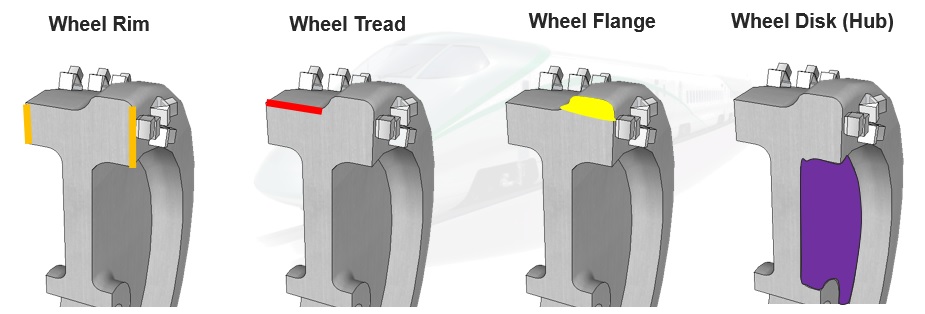DTEC GmbH is an NDT equipment supplier located in Frankfurt Rhein-Main, Germany. The company specializes in turnkey solutions for flaw detection in railway wheelsets and train condition monitoring.
Using an advanced phased array ultrasonic testing (PAUT) technique and machine vision, DTEC GmbH has created intelligent automated systems that provide inspection services for railway safety.
DTEC GmbH’s automated inspection system solutions are used to perform:
- Wayside wheel inspection
- In-service wheel and axle inspection when wheelsets are on train
- Routine wheel and axle maintenance phases when wheelsets are dismounted from the train
In railway maintenance depots and workshops, specialized automated wheel inspection systems (WIS) detect manufacturing flaws, defects, and fatigue cracks in high-speed train, locomotive, and rolling stock wheels and axles. These advanced WIS systems use Olympus’ FOCUS PX PAUT instrumentation.
“The Olympus FOCUS PX makes our star product, the Underfloor Wheelset Ultrasonic Testing System (UW-UT, or UFPE in German), an excellent solution for modern railway maintenance depots. It enables them to inspect wheels for fatigue cracks without needing to remove the wheelset from the vehicle,” says Dr. Eric Peng, Chief Engineer at DTEC GmbH.
The Challenge: Inspecting Wheelsets without Dismounting Them
On trains, wheelset components are subjected to the highest loads. Both wheels and rails are susceptible to rolling-contact fatigue (RCF), which is when cracks grow due to the contact stresses between a rolling wheel and the rail. RCF can induce spalling (flaking) and shelling defects in the wheel tread. Some subsurface and inner defects can develop circumferentially and cause the wheel rim to lose chunks of material. Bulk material loss is dangerous and can result in a derailment. Monitoring the rail-wheel contact and the continuous cycling stress of the axles can help avoid component defects before they cause a failure.
Railway operators can use conventional ultrasonic testing (UT) to conduct periodic NDT inspection of train wheels. However, with the manual UT method, inspectors are unable to achieve full 360-degree-circumferencial flaw detection of wheels, mainly because of the complicated structure of train cars’ undercarriage.
Compounding the inconvenience of manual UT, this kind of inspection work is normally scheduled during the night shift to limit the impact on the vehicle’s operation time. In some cases, the wheelsets must be removed from the vehicle, which exponentially increases workload time and cost. The challenge DTEC GmbH faced was to implement an efficient, accurate, reliable, and automatic UT system for wheel inspection while keeping the wheels on the vehicle.
UT Inspection Requirements on High-Speed Train Wheels
Speed is a critical function of high-speed trains, but so are safety and stability. The wheels, as a key component of a high-speed train vehicle, require a lot of attention during maintenance—the tread, flange, rim, and disk must be thoroughly inspected to ensure their integrity. “To cover all critical wheel areas with their irregular surfaces requires a system of different ultrasonic skills,” says Eric.

Critical wheel areas with their irregular surfaces
Table 1 shows the light-maintenance UT inspection coverage requirements for high-speed train wheels, including the required UT probe types, configuration, and coupling. According to Eric, “At the beginning, we thought about using 62 total conventional UT probes in the system to do the job. However, there is not enough space in the undercarriage area for such a probe arrangement.”
Table 1
| Probe Types | Coupling Position | Targeted Area | Targeted Defects |
|---|---|---|---|
| Dual elements | Wheel tread |
Wheel rim
Wheel disk |
Inner defect
Circumferential crack |
| Wheel back rim | Wheel rim | Inner defect | |
|
Angle Beam
(Pulse-echo model) | Wheel tread |
Wheel rim
Wheel disk | Radial crack |
| Wheel back rim | Wheel rim | Crack at chamfer | |
|
Angle Beam
(Pitch-catch model) | Wheel tread | Wheel disk | Circumferential crack |
PAUT uses probes that contain a set (array) of ultrasonic transducers (elements). Ultrasonic phased array systems can potentially be employed in almost any test where conventional ultrasonic flaw detectors have traditionally been used. The benefits of phased array technology over conventional UT come from its ability to steer, focus, and scan beams using the multiple elements in the array.

Phased array testing compared to conventional UT. The ability to test welds with multiple angles and depths from a single probe can increase the probability of detecting an anomaly.
The small footprint of phased array probes and the ability to sweep beams electronically ease the inspection of components where there is limited access for mechanical scanning, such as wheels in the undercarriage. On the downside, phased array probe technology is usually more expensive, and operators may require additional training to use it. However, these costs are frequently offset by the greater flexibility and increased inspection efficiency that PAUT systems provide.
By integrating Olympus PAUT technology, the number of probes that DTEC GmbH’s UW-UT system uses is about half of what would be required using conventional UT transducers. The probe carrying device is more compact, and it is also compatible with the many different wheel types that they need to inspect.
Wheelset Inspection Solution: An Automated FOCUS PX and FocusPC Driven System
The FOCUS PX data acquisition unit is a high-performance conventional UT and PA instrument designed for automated inspection systems. It has a robust casing—for example, it requires no air intake—and it's tested to handle long operation hours in harsh production environments. It’s scalable, easy to integrate, and quick to program.

FocusPC software offers powerful inspection features, advanced analysis tools, and fully customizable displays. It drives up to four FOCUS PX acquisition units in parallel and can combine the data in a user-defined display. Features of the FOCUS PX and FocusPC system, such as the large data file storage, flexible compression and digitizing rates, and conditional A-scan saving, enable large parts to be inspected without interrupting the inspection sequence.
Integrated Application: Underfloor Wheelset Ultrasonic Testing System
DTEC GmbH’s UW-UT (or UFPE) is a fully automatic ultrasonic wheel inspection system for use during light maintenance. When a train is on the maintenance track, the UW-UT system is run under the train undercarriage to automatically lift and rotate each wheelset.
At the same time, twin robots position PA probes on both wheels. In less than one minute, and with one rotation of the wheelset, the FOCUS PX instrument acquires the ultrasonic data and transfers it to the customized WIS software program. A minute after that, the automatic inspection report is ready for the operator to review.
Key features of DTEC GmbH’s UW-UT system:
- Automatic positioning and inspection
- UT data acquisition: ≤1 min/wheelset
- A/B-scan, bar chart, wheel side view data analysis
- Flaw detection ability:
- Equivalent defect in wheel rim: ≥ 2 mm FBH
- Equivalent crack on wheel rim: 10 mm×3 mm
- Equivalent crack on wheel disk: 15 mm×3 mm
- Equivalent defect in wheel disk: ≥ 3 mm SDH
 |  |
UW-UT system on a calibration reference wheelset (left) and an on-vehicle wheelset inspection (right). |
The Results: Powerful PAUT Inspection and Data Management
In the UW-UT system, for every 1 mm rotation of the wheel tread, multiple ultrasonic beam sets (or focal laws) are simultaneously triggered to perform 50 A-scans for each wheel. For a 920 mm diameter wheelset inspection, the total number of A-scans is about 30,000. It requires a powerful instrument such as the Olympus FOCUS PX unit to execute this data acquisition and data transfer in real time.
Because there is such a large volume of data collected with each inspection, DTEC GmbH has set up specialized data management for their operators:
- A bar chart is used for channels where an automatic alert can be applied, and an operator can select bars to receive related B-scan and A-scan data.
- For channels where a manual confirmation is required—for example, the channels for a wheel disk—a wheel side view is created by combining several B-scans, which are corrected according to the wheel diameter.
- Operators can easily see whether there is a defect in a wheel using the bar chart and wheel side views, then they use the A-scans and B-scans to determine defect details, such as location, depth, and severity.
- When the operator uses the mouse to click-and-drag a window around a defect on a B-scan, these data (location, depth, etc.) are calculated automatically.

Bar chart, A- and B-scan associated analysis
Fully automated, advanced PAUT technology and powerful data management make DTEC GmbH’s UW-UT system intelligent and easy to operate. Since 2009, 130 UW-UT systems have been installed in the field, successfully detecting numerous wheel fatigue cracks. After removing the cracks with a lathe, these wheels can be safely put back into service.
 |  |
Wheel fatigue crack findings (left) before and (right) after tread reprofiled |
Applying the FOCUS PX System Solution to Other Railway Wheelset Maintenance
DTEC GmbH also developed the Dismounted Wheelset Ultrasonic Testing (DW-UT) system. The ultrasonic technologies used in this equipment are like those in the UW-UT system, but this time applied to dismounted wheelsets.
 |  |
Dismounted wheelset and solid axle ultrasonic testing systems |
By employing Olympus technology and instrumentation, DTEC GmbH has succeeded in producing efficient, intelligent, and automated solutions to help ensure safer and smarter railways.
Related Content
Right on Time: An Efficient and Reliable Train Wheel Inspection System (WIS)
Automated Train Wheel Inspection Systems
Inspecting Train Wheels Using Phased Array
Get In Touch





